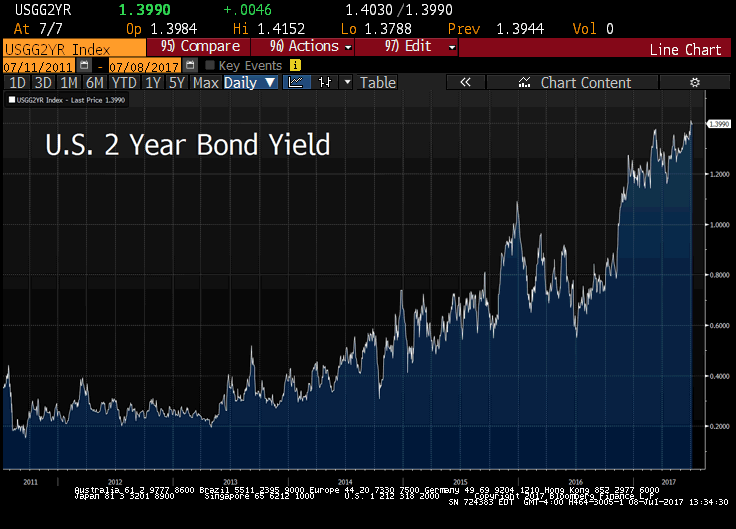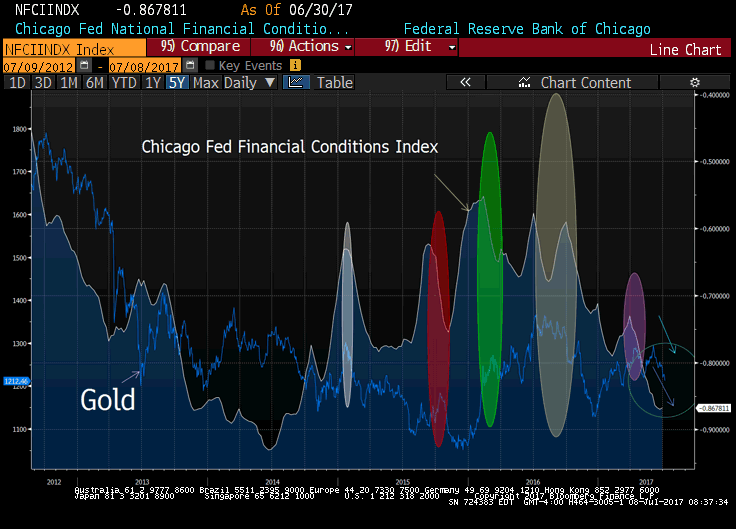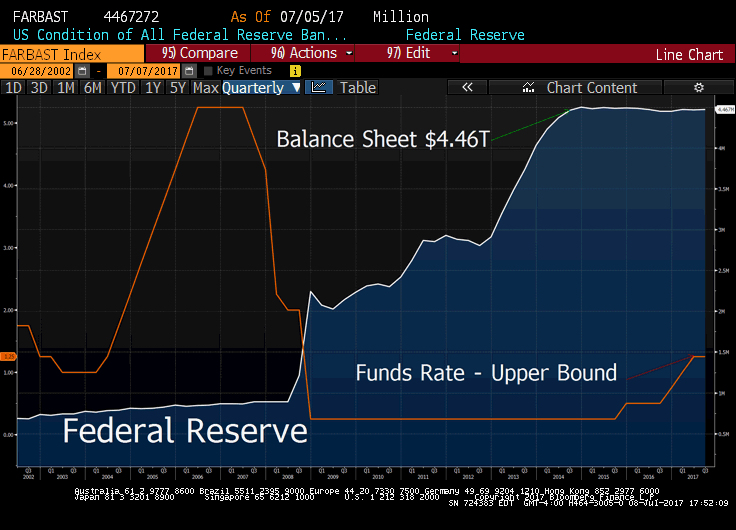Join our Larry McDonald on CNBC’s Trading Nation, Wednesday at 3:05pm ET
Pick up our latest report here:
Don’t miss our next trade idea. Get on the Bear Traps Report Today, click hereUpdated, July 11, 2017 at 6:45pm
Breaking: Gary Cohn is now the leading candidate to succeed Yellen as the world’s most important central banker…
President Donald Trump is increasingly unlikely to nominate Federal Reserve Chair Janet Yellen next year for a second term, four people close to the process told Politico.
Yellen’s Job is Cohn’s if he wants it, and he would win Senate confirmation easily, one Republican close to the selection process told Politico.
National Economic Council Director Gary Cohn is now the leading candidate to succeed Yellen as the world’s most important central banker, these people said. Yellen begins two days of congressional testimony on Wednesday, and her own future in the job may come up in questioning.
You have to go back to the 1970s to see a non-economist Fed Chair, we’ve been telling clients all year – we believe Trump wants a practitioner, NOT another academic who’s never taken professional risk. G. William Miller was Fed Chair under President Jimmy Carter, the last Chair outside academia to run the world’s most powerful central bank.
Yellen’s Legacy Has an Impact on Markets
Gold prices plunged again Friday, now 7% off their June highs, while the gold miners GDX sits 12% lower over the same period. What’s going on?
As central bankers from the U.S., Canada, Europe and Asia have turned more hawkish (publicly discussed pulling back accommodation) – bond yields have surged while gold has plunged.
“If we were not to withdraw accommodation, the risk would be that the economy would crash to a very, very low unemployment rate and generate inflation. Then the risk would be that we would have to slam on the brakes and the next stop would be a recession.”
Bill Dudley, New York Federal Reserve Bank – July 2017
Implied Probability of Deposit Rate Hike from the ECB*
July: 66%
June: 20%
*OIS swaps, looking out over the next 11 months to June 2018. Most of this move higher occurred after Mario Draghi’s speech last week. Banks like HSBC are anxiously adjusting their outlook, now forecasting 10-yr German bund yields will hit 90bps (53bps today – 22bps in June)) by year-end. The breadth of that kind of sell off brings back memories of Jean Claude Trichet’s ECB. Their 2011 rate hike was judged by most market participants as a disaster – pulling back accommodation into a deflation storm.
“We’ve not only reached full employment mark – we’ve exceeded it by a fair amount. If we delay too long, the economy will eventually overheat, causing inflation or some other problem.”
John Williams, San Francisco Federal Reserve Bank – July 2017
In our opinion, President Trump is in Fed chair Yellen’s head – legacy in on her mind. With Yellen’s term up in February and receiving no visibility on a White House re-appointment – Yellen has been digging in. She’s taking this opportunity to pen a few pages in the history books. After years of gross over-accommodation – an easy money gravy train pumping up asset bubbles – Yellen’s Fed is singing a far different tune today. If she goes out – the Yellen Fed wants the world to know in their last 9 months of service, they tried to let some air out of the balloon.
Fed Chair Yellen on Capitol Hill, July 12-13
Federal Reserve Chair Janet Yellen has been making the case – strong hiring will feed through to higher wages and price pressures over time. She will explain her views on the labor-market and the Fed’s colossal balance sheet (levered 77-1 see below) when she delivers semi-annual testimony to Congress next week. She speaks to the House Financial Services Committee on July 12 and the Senate Banking Committee on July 13.
Short Positions in Gold Futures and Options*
July: 96k
June 63k
May: 51k
April: 41k
*CFTC data, highest since January 2016 – signals that global central banks are shifting ever closer to pulling back economic stimulus helped boost bearish bets on the gold to the highest in almost 18 months.
U.S. 2 Year Bond Yield

A hawkish turn by the Fed has two year bond yields at 6 year highs. Government bonds globally have lost nearly $350B in recent weeks under the bond sell off siege.
Pick up our latest report here:
Don’t miss our next trade idea. Get on the Bear Traps Report Today, click hereTo add fuel to the fire, this week’s ECB minutes (European Central Bank) hint toward coordination with Yellen’s FOMC. The “financial conditions” targeting narrative we laid our in our Bear Traps Report (in June) is picking up believers, moving toward a consensus view.
Financial Conditions are Driving the Gold Bus
 We have an index of our 21 Lehman Systemic Risk Indicators, the Chicago Fed’s Financial Conditions Index is similar above. Over much of the last five years – as financial conditions tightened, gold surged (see above). On the other hand, in 2017 we’ve witnessed a regime change. This year as the Fed has hiked rates twice – financial conditions eased – NOT tightened. As long as financial conditions are NOT stressed – Yellen’s Fed has runway on the hawkish side to pull back accommodation. Relationship to gold? A year ago today there were close to $15T of negative yielding bonds on earth – this number is now well below $7T today. As bond yields have surged – globally gold is far less attractive to hold – the macro impact on this metal has been profound.
We have an index of our 21 Lehman Systemic Risk Indicators, the Chicago Fed’s Financial Conditions Index is similar above. Over much of the last five years – as financial conditions tightened, gold surged (see above). On the other hand, in 2017 we’ve witnessed a regime change. This year as the Fed has hiked rates twice – financial conditions eased – NOT tightened. As long as financial conditions are NOT stressed – Yellen’s Fed has runway on the hawkish side to pull back accommodation. Relationship to gold? A year ago today there were close to $15T of negative yielding bonds on earth – this number is now well below $7T today. As bond yields have surged – globally gold is far less attractive to hold – the macro impact on this metal has been profound.
Negative Yielding Bonds on Earth in July (in Trillions)
2017: $6.1T
2016: $15.1T
Bloomberg data
Fed Fund Futures, only Pricing in a 19% Chance of a September Rate Hike
Wall St. has unanimously read the Fed’s recent hawkish turn with focus on the Fed’s balance sheet, NOT rate hikes. At a colossal $4.46T, most of Wall St’s economists see the Fed reducing the size of its SOMA* in September. Wall St’s braintrusts like to hangout together, they typically think very much alike. A year ago today, NOT one firm on the Street believed the Fed would touch the SOMA in 2017, or 2018 for that matter. Today, they’ve moved up their expectations in a panicked hurry.
System Open Market Account (SOMA)
*The Federal Reserve System Open Market Account (SOMA) is a portfolio of U.S. Treasury and Federal Agency securities, foreign currency investments and reciprocal currency arrangements.
Central Bank Assets as a % of GDP
2007 to 2017
BOJ: 18% to 92%
ECB: 12% to 40%
BOE: 3% to 27%
FOMC: 7% to 23% (SOMA)
Bloomberg
Fed’s Balance Sheet (SOMA) and Funds Rate
 We must keep in mind, in February there was only a 17% probability of a Fed rate hike in March (according to Wall Street’s economists). This was before the Federal Open Market Committee (FOMC ) began shifting market expectations and ultimately tightened (hiked rates) in March. Rule #1, more often than NOT – Wall St. gets the Fed wrong. Today, the entire street has their eye on September SOMA reduction – rate hikes are (near) unanimously a December issue in terms of street expectations. Our Bear Traps Report research team meticulously measures the breath of crowded trades on Wall St. – very often this is where alpha is found, going the other way.
We must keep in mind, in February there was only a 17% probability of a Fed rate hike in March (according to Wall Street’s economists). This was before the Federal Open Market Committee (FOMC ) began shifting market expectations and ultimately tightened (hiked rates) in March. Rule #1, more often than NOT – Wall St. gets the Fed wrong. Today, the entire street has their eye on September SOMA reduction – rate hikes are (near) unanimously a December issue in terms of street expectations. Our Bear Traps Report research team meticulously measures the breath of crowded trades on Wall St. – very often this is where alpha is found, going the other way.
Join our Larry McDonald on CNBC’s Trading Nation, Wednesday at 3:05pm ET
Pick up our latest report here:
Don’t miss our next trade idea. Get on the Bear Traps Report Today, click here

